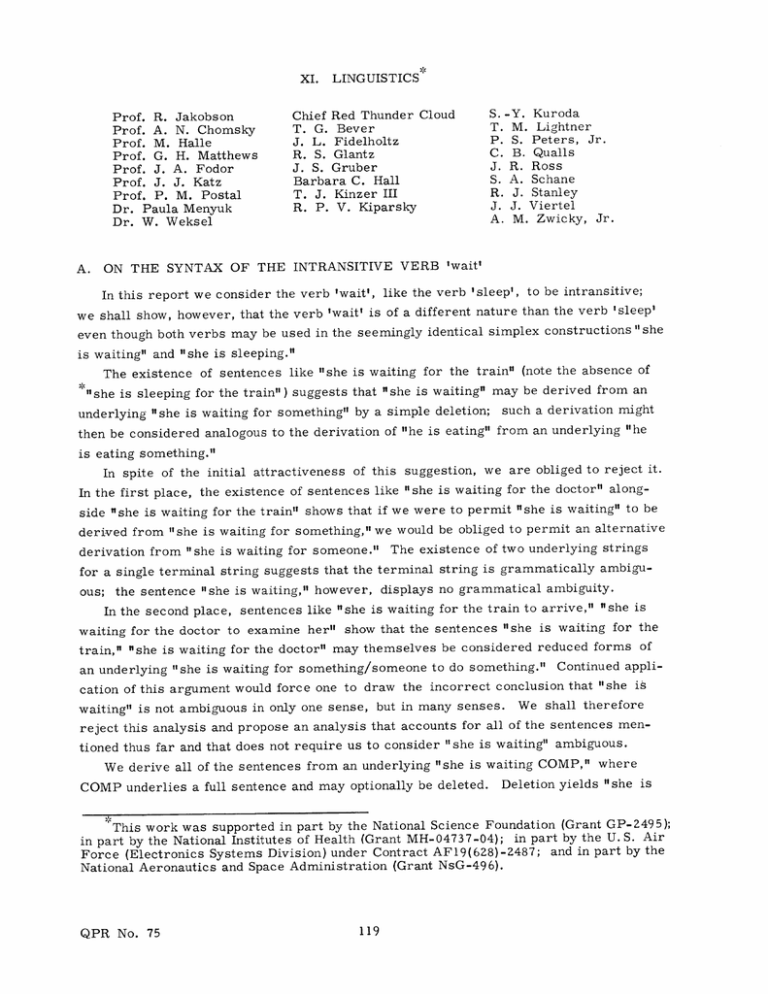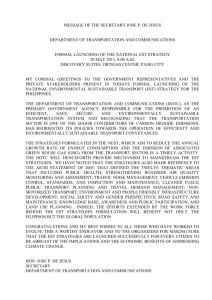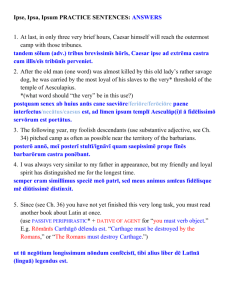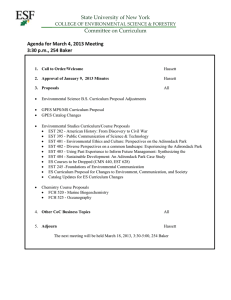XI. LINGUISTICS S. -Y. Kuroda
advertisement

XI.
Prof. R. Jakobson
Prof. A. N. Chomsky
Prof. M. Halle
Prof. G. H. Matthews
Prof. J. A. Fodor
Prof. J. J. Katz
Prof. P. M. Postal
Dr. Paula Menyuk
Dr. W. Weksel
A.
LINGUISTICS
Chief Red Thunder Cloud
T. G. Bever
J. L. Fidelholtz
R. S. Glantz
J. S. Gruber
Barbara C. Hall
T. J. Kinzer III
R. P. V. Kiparsky
S. -Y. Kuroda
T. M. Lightner
P. S. Peters, Jr.
C. B. Qualls
J. R. Ross
S. A. Schane
R. J. Stanley
J. J. Viertel
A. M. Zwicky, Jr.
ON THE SYNTAX OF THE INTRANSITIVE VERB 'wait'
In this report we consider the verb 'wait',
like the verb 'sleep',
to be intransitive;
we shall show, however, that the verb 'wait' is of a different nature than the verb 'sleep'
even though both verbs may be used in the seemingly identical simplex constructions " she
is waiting" and "she is sleeping."
The existence of sentences like "she is waiting for the train" (note the absence of
"she is sleeping for the train") suggests that "she is waiting" may be derived from an
underlying "she is waiting for something" by a simple deletion;
such a derivation might
then be considered analogous to the derivation of "he is eating" from an underlying "he
is eating something."
In spite of the initial attractiveness
of this suggestion, we are obliged to reject it.
In the first place, the existence of sentences like "she is waiting for the doctor" alongside "she is waiting for the train" shows that if we were to permit "she is waiting" to be
derived from "she is waiting for something," we would be obliged to permit an alternative
derivation from "she is waiting for someone." The existence of two underlying strings
for a single terminal string suggests that the terminal string is grammatically ambiguous; the sentence "she is waiting," however, displays no grammatical ambiguity.
In the second place, sentences like "she is waiting for the train to arrive," "she is
waiting for the doctor to examine her" show that the sentences "she is waiting for the
train," "she is waiting for the doctor" may themselves be considered reduced forms of
an underlying "she is waiting for something/someone to do something." Continued application of this argument would force one to draw the incorrect conclusion that "she is
waiting" is not ambiguous in only one sense, but in many senses. We shall therefore
reject this analysis and propose an analysis that accounts for all of the sentences mentioned thus far and that does not require us to consider "she is waiting" ambiguous.
We derive all of the sentences from an underlying "she is waiting COMP," where
COMP underlies a full sentence and may optionally be deleted. Deletion yields "she is
This work was supported in part by the National Science Foundation (Grant GP-2495);
in part by the National Institutes of Health (Grant MH-04737-04); in part by the U. S. Air
Force (Electronics Systems Division) under Contract AFl9(628)-2487; and in part by the
National Aeronautics and Space Administration (Grant NsG-496).
QPR No. 75
119
(XI.
LINGUISTICS)
waiting."
If COMP is not deleted, we require insertion of the element for and the use of
an infinitival form of the main verb within the COMP. This process yields "she is waiting
for the train to arrive" and "she is waiting for the doctor to examine her." If a dummy
verb is used in the COMP, we derive the reduced sentences "she is waiting for the train"
and "she is waiting for the doctor."
The passive transformation may apply to strings under the node COMP, thereby producing sentences like "she is waiting for John to be examined by the doctor." If the
object of the verb in the COMP is the same as the subject of 'wait', and if the string
under the node COMP undergoes the passive transformation, then the usual deletion of
repeated elements occurs and produces "she is waiting to be examined by the doctor"
and not "she is waiting for herself to be examined by the doctor." Addition of a marker
for extra-heavy stress (emphasis) may block deletion of repeated elements to derive
"she is waiting for HERSELF to be examined by the doctor."
Wh-transformations may apply within the COMP, but only if the dummy verb is used.
These transformations will derive sentences like "who/what is she waiting for." Note
the absence of "who is she waiting for to examine her" and "what is she waiting for to
arrive."
The Neg-transformation may apply within the COMP only when marked with extraheavy stress, as in "she is waiting for the train NOT to arrive" and "she is waiting for
the doctor NOT to examine her." For some speakers these sentences may be marginal
or unacceptable.
Nominalization transformations may apply within the COMP; if the verb 'await' is
used in place of 'wait', the element for does not occur: "she is waiting for the arrival
of the train," "she is awaiting the arrival of the train," "she is waiting for the construction of an even larger building," "she is awaiting the construction of an even larger
building," etc., but not "she is awaiting for the arrival of the train," "she is awaiting
for the construction of an even larger building," etc.
If the verb phrase in the COMP contains an object, nominalizations produce nongrammatical sentences like "she is (a)waiting (for) the doctor's examination of
her(self)" (from "the doctor examines her"), "she is (a)waiting (for) the winning of
the Series by the Dodgers" (from "the Dodgers win the Series"), "she is (a)waiting
(for) the breaking of a window by the storm" (from "the storm breaks a window"),
"she is (a)waiting (for) his covering of the table with a cloth" (from "he
covers the
table with a cloth").
Note that sentences like "she is (a)waiting (for)an outstanding generative phonologist's
analysis of the morphophonemic component of Russian" are not derived from the COMP
"an outstanding generative phonologist analyzes the morphophonemic component
of
Russian," but from the COMP "an outstanding generative phonologist VERB
dum an
analysis of the morphophonemic component of Russian," as can be seen from the
QPR No. 75
120
(XI.
LINGUISTICS)
existence of sentences like "she is waiting for an outstanding generative phonologist to
present/to discover/to think up/ ... an analysis of the morphophonemic component of
Russian."
T. M. Lightner
ON THE PHONOLOGY OF tort, tolt, tert, telt IN OLD CHURCH
B.
SLAVONIC AND RUSSIAN
It is well known that the Proto-Slavic clusters *tort, *tolt, *tert, *telt developed
to trat, tlat, tret, tlvt in Old Church Slavonic (OCS) and to torot, tolot, teret, tolot in
In this report, we discuss the mechanism of these two developments and
Russian (R).
show that the historical development must be reflected in the synchronic descriptions
of OCS and R. We use the abbreviations C for any segment specified [+ consonantal],
V for any segment
specified
,
L for any segment
nsonantaland
+ vocalic
specified
consonantal]
.I+ vocali
+ consonantal
The OCS development is accounted for by application of the following transformational rules:
(A) Structural Description:
where
C V L C
XlY-tense
X1
Structural Change:
(B) SD:
V
1
SC:
11
SD:
C V L C
X1 2Y
SC:
12 - 21
(C)
-
V
tensediffuse
Y
1 - 11
+ tense
where
V = [- diffuse]
The development of OCS grad-' 'city',
from the underlying root gord is thus as
follows:
gord
-A-
goord
-B-
gord
-C-
grod = grad
In Russian, the development is the same, except that rule B does not apply; R
gorod 'city' thus has the following development:
gord
-A-
goord
-C-
gorod
The synchronic descriptions of OCS and R must contain these rules in order to
QPR No. 75
121
(XI.
LINGUISTICS)
account for the alternations VL ~ LV (OCS) and VL ~ VLV (R): OCS inf. klati 'to stab'
and 3 sg. koijet~ 'stabs'; R inf. kolot' 'to chop' and 3 sg. kolet 'chops'. The root cluster
ol in both languages undergoes the application of rules A-C in the inf. because the cluster lies before a consonant; in the pres. tense forms, however, ol does not lie before
a consonant and therefore remains unaffected by rules A-C.
The gravity of lax vowels before IC in R is accounted for by application of the following rule:
(D)
F+
vocalic
- consonantal
- tense
]
[+ grave]
in env:
1 C
The synchronic derivation of the el cluster in R inf. molot' and 3 sg. melet 'grind',
for example, is as follows (note that D must apply before A):
3 sg:
Inf:
mel+e+t
mel+t'
-D-
-D-
no
mol+t'
-A-
-A-
no = melet
mool+t'
-C-- molo+t'
= molot'
We shall now account for the existence of pairs of forms in R of the type
gorod ~ grad, bereg ~ breg, molod ~ mlad, etc.1 Each of the pairs is derived from a
single underlying lexical morpheme. The difference in derivation is accounted for by
marking the lexical morpheme either [+R] or [-R]. The synchronic rules, given in the
order in which they must apply, are as follows:
(D)
+ vocalic
- consonantal
1-
[+ grave]
in env:
+R
- tense
(A) SD:
SC:
(B) SD:
SC:
(C) SD:
SC:
C V L C
X1 Y
where
V =-
diffuse
tense
1 - 11
+ vocalic
- consonantal
-R
1
11-
+ tense]
C V L C
X1 2 Y
where
V = [- diffuse]
12 - 21
The following are sample derivations:
QPR No. 75
122
1C
(XI.
rgord1
gorod:
-D-
[+R J
no
-D-
gord
grad:
no
+R j
-D-
[molk+o]
=
molok+o
gorod
-C-
gr5d = grad
-R
-B-- no
moolk+o
+R
-A-r
+R
+R
I
-C-
grdj
-R
melk+o
-C-
moloko
melk+o
mleko:
no
-B-
goord
-A-
[ -R
moloko:
-B-
goord
-A-
LINGUISTICS)
-D-
no
-A-
-B-
meelk+o
melk+o
-C-
-R
-R
mlek+o = mleko
M.
Halle, T.
M. Lightner
References
v
V
1. The pairs of this type have been exhaustively listed by Saxmatov,
sovremennogo russkogo literaturnogo jazyka (Leningrad, 1930), pp. 21-25.
C.
Ocerk
HISTORICAL DEVELOPMENT OF THE FRENCH SYNTACTIC CONSTRUCTION:
Ce + ETRE + noun or pronoun
In this report we shall undertake to formulate a small set of transformational
rules to explain the various stages in the development of the syntactic construction:
ce + ETRE + noun or pronoun.
All data for the early periods of the language are taken from Foulet.
The forms that
we cite have been normalized in accordance with current French orthography.
1. Background
We shall speak of three separate stages in order to classify the data conveniently,
without being specific as to the exact point of division between these successive stages.
In Stage I (XII century) one finds the following type of paradigm:
Here it
Ce suis je
Ce sommes nous
Ce es tu
Ce etes vous
Ce est il
Ce sont ils
seen that the form of the verb is
is
predicate ce standing in word initial position.
determined by the following subject;
It should be borne in mind that all nouns
and pronouns at this stage of the language were in one of two cases, the nominative
the oblique;
QPR No.
75
the
or
hence, sentences of the type object-verb-subject were about as equally
123
(XI.
LINGUISTICS)
common as subject-verb-object.
however,
In constructions of the type which we are examining,
ce tended to be the preverbal element.
In Stage II (XIV century) case distinction had been lost in nouns;
more rigid;
the first noun or pronoun was generally the subject.
word order became
In the construction,
Ce + ETRE + noun or pronoun, ce becomes grammatical subject, the paradigm then being
*Ce est je
Ce est nous
Ce est tu
Ce est vous
Ce est il
'Ce
est ils
The forms preceded by an asterisk have never been attested. Weakened je was replaced
by moi, whereas ce sont ils probably persisted for some time as a unique form.
In Stage III (Modern French) the ce est moi type of paradigm becomes generalized:
C'est moi
C'est nous
C'est toi
C'est vous
C'est lui
C'est eux
C'est eux has often been considered as colloquial.
There is
also the somewhat more
literary alternative Ce sont eux.
Also in Modern French the disjunctive form of the
pronoun has replaced the conjunctive. This change will not be discussed, as it is not
directly relevant to the syntactic problem as herein formulated.
2.
The Data
In addition to the Ce + ETRE + pronoun construction, the third position can also be
occupied by a noun; e. g., Ce est Jean (Stage I).
Although the latter superficially
resembles its pronoun counterpart Ce est il, structural differences are apparent when
one examines the nondeclarative forms:
negative, ce ne est il pas :
ce?
sort.
interrogative,
ce ne est pas Jean;
est il ce?
:
est ce Jean?;
negative-interrogative,
ne est il pas
The rules of the grammar must explain differences of this
We append a chart summarizing the different orderings of pronouns and nouns for
: ne est pas ce Jean?
each stage of the language.
Declarative
Interrogative
Negative
Neg-Interrog
I
ce es tu
es tu ce
ce ne es tu pas
ne es tu pas ce
II
ce est tu
est ce tu
ce ne est tu pas
ne est ce tu pas
III
c'est toi
est-ce toi
ce n'est pas toi
n'est-ce pas toi
I
ce est Jean
est ce Jean
ce ne est pas Jean
?ne est pas ce Jean
II
ce est Jean
est ce Jean
ce ne est pas Jean
?ne est ce pas Jean
III
c'est Jean
est-ce Jean
ce n'est pas Jean
n'est-ce pas Jean
Tu, of course, is representative of the other pronouns of the paradigms; Jean is typical
QPR No. 75
124
(XI.
of nouns.
LINGUISTICS)
For each stage we shall construct a different grammar to explain the facts for
that stage.
3.
Stage I
This stage is characterized by
1) verb is determined by the following subject;
2)
ce is inverted in questions;
3)
pronoun subject precedes other elements (pas and/or ce) in negation and/or
interrogation;
4)
noun subject follows the other elements in negation and/or interrogation.
The ? before ne est pas ce Jean indicates that this form was not given by Foulet and
has been reconstructed on the basis of the other forms (which are all given by Foulet).
The following is
a small segment of a phrase-structure grammar.
It will produce
the underlying strings for those forms noted above as data, as well as several other
derivations not discussed here.
These rules do not purport in any sense to be complete.
They are but a fragment that would doubtlessly be changed considerably if a more complete grammar were considered.
Their purpose here is therefore an illustrative one.
1.
SS -
(NEG)
(QU) NP Aux VP
2.
VP --
aV
NPed
(Adv)
_Pred
ETRE
3.
trans
V --
in env:
in env:
Pred
NP
in env:
Aux VAdj
Loc
Vintrans
4.
Pred
(Adj
Loc
-
NP
5.
NP
N -
r
(Det)
N
PPro
6.
Pron -
ce
rN
7.
com
com
N --I
8.
Aux --
9.
Tense
QPR No. 75
in env:
Aux V
Det
pro p
Tense
{pres
past
etc.
125
(XI.
LINGUISTICS)
10.
Adv -.
11.
Vtran s --
12.
Vi
13.
Adj --
14.
Loc --
15.
PPro --
je, tu, etc.
16.
N corn -
gargon, etc.
17.
N
18.
Det -
aujourd'hui, etc.
intrans
prop
regarde, etc.
---
marche,
etc.
brave, etc.
l-bas,
---
etc.
Jean, etc.
le, un, etc.
From the rules above we can derive the underlying strings:
es ce, after subject-verb agreement and morphophonemics);
est ce).
Tu pres ETRE ce (Tu
Jean pres ETRE ce (Jean
A sample of a derivational tree follows:
S
QU
NP
.
VP
.
Aux
Pron
Tense
I
PPro
I
Pres
Pred
ETR
N
ETRE
NP
Pron
I
ce
Diagram 1
We shall need, in addition, the following four transformational rules to handle those
forms in question:
4 - 2 - 3- 1
NP - Aux - V - ce ==
A)
Ce-placement:
B)
Inversion:
QU - NP - Aux - V ===> 3+4 - 2 - 0 - 0
C)
Negation:
NEG - X - Tense - V =-
D)
Pronoun-attraction:
QPR No. 75
V- X-
0-
PPro ==
126
2 - ne+3 - 4+pas
1+3 -
2 - 0
(XI.
LINGUISTICS)
Rule A interchanges ce and the subject; rule B inverts the subject and verbal complex
(Aux - V) in interrogative forms;
rule C places ne... pas around the verbal complex in
rule D places the pronoun subject immediately after the verb. Complete derivations follow. It should be noted that in the derivations verb forms are given
in their orthographic representation for the convenience of the reader. These verb forms
negative forms;
should really be interpreted as the verbal complexes (Aux-
V; i.e., Pres - ETRE)noted
above.
tu es ce
ce es tu
QU tu es ce
QU ce es tu
es ce tu
ce es tu
es tu ce
Jean est ce
ce est Jean
QU Jean est ce
QU ce est Jean
est ce Jean
NEG tu es ce
NEG ce es tu
ce ne es pas tu
ce ne es tu pas
NEG Jean est ce
NEG ce est Jean
ce ne est pas Jean
4.
NEG QU tu es ce
NEG QU ce es tu
NEG es ce tu
ne es pas ce tu
ne es tu pas ce
NEG QU Jean est ce
NEG QU ce est Jean
NEG est ce Jean
ne est pas ce Jean
Stage II
The phrase structure is similar to Stage I. The proper restrictions must be set up
- Tense - ETRE- ce (e. g.,
ro
instead of
Pro
to derive ce - Tense - ETRE Aux V Pred. This allows ce to determine the form of the
ce in env
Pron -verb.
No additional rules of the type A-D are needed;
these are simply reordered and A),
the ce-placement rule, is eliminated.
New ordering:
Negation
Pronoun- attraction
Inversion
Complete derivations follow:
ce est tu
QU ce est tu
ce est tu
QU ce est tu
est ce tu
ce est Jean
QU ce est Jean
NEG ce est tu
ce ne est pas tu
ce ne est tu pas
NEG QU ce est tu
QU ce ne est pas tu
QU ce ne est tu pas
ne est ce tu pas
NEG ce est Jean
ce ne est pas Jean
NEG QU ce est Jean
QU ce ne est pas Jean
ne est ce pas Jean
est ce Jean
5.
Stage III
As in Stage II, for Stage III we eliminate one of the rules B-D, reordering the
remaining two:
QPR No. 75
127
(XI.
LINGUISTICS)
New ordering:
Negation
Inversion
Complete derivations follow:
c'est toi
QU c'est toi
NEG c'est toi
ce n'est pas toi
NEG QU c'est toi
QU ce n'est pas toi
n'est-ce pas toi
NEG c'est Jean
ce n'est pas Jean
NEG QU c'est Jean
QU ce n'est pas Jean
n'est-ce pas Jean
est-ce toi
c'est Jean
QU c'est Jean
est-ce Jean
It is interesting to note that for each of the stages, once the underlying string is
established, the same set of rules A-D) is used to derive all forms, although the full set
of rules is not necessarily used for each subsequent stage and ordering varies.
6.
Stage I
Stage II
Stage III
ce-placement
Inversion
Negation
Pronoun- attraction
Negation
Pronoun- attraction
Inversion
Negation
Inversion
Thus
Conclusion
It is seen that linguistic change is not simply the result of different grammatical rules
operating at each given stage in the development of the language. Nor is it simply the
addition of new rules or the elimination of other rules.
There also remains to be con-
sidered the possibility of a set of rules from one stage of the language undergoing
reordering in the subsequent stage. The latter factor, in addition to the others considered, accounts for the diversity in output which is observable from one stage of the
language to the next.
S. A. Schane
References
1. L. Foulet, Comment on est pass6 de <Ce suis je >
83 (1920).
QPR No. 75
128
a <C'est moi >, Romania, 46-





